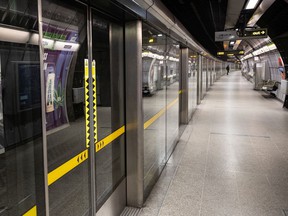It’s unknown what will happen to roughly $800 million promised by the province.

Article content
A project to build barrier doors on several stations of the métro’s Orange Line has been shelved, despite roughly $200 million in provincial funds promised for that project.
advertisement 2
Article content
The barriers, also known as platform screen doors, consist of panels that block off access to the track, with doors that line up with the doors of incoming trains. They have been installed in the subway systems of several major cities, notably Paris, Hong Kong, London, Tokyo and Singapore, and they prevent people from jumping or being pushed onto the track, or from falling objects. The city’s new Réseau express métropolitain will be equipped with the barriers in all of its 26 stations when it launches starting this year.
In 2018, the city’s transit agency put out a call for tenders to install the barriers in 13 stations. Then in 2019, the city announced it reached a deal with the province to pay for at least 13 of those barriers. In the deal, which was announced with much fanfare at City Hall, the province pledged a total of $800 million for various transit projects, $200 million of which would pay for the barriers. The Société de transport de Montréal had estimated that equipping each station would cost between $10 and $15 million, so the $200 million would have paid for all 13 stations.
advertisement 3
Article content
However, the project was quietly shelved by the STM in December, spokesperson Philippe Déry explained. It was left out of a new capital expenditure budget unveiled at the end of last year that covers the years 2022 to 2031.
“In the context of financial difficulties linked to the pandemic, the STM made the necessary efforts to reduce its debt, so we reduced our expenses by more than $2 billion over 10 years. To do that, we revised some projects and canceled others,” Déry said.
The previous capital budget had planned for $568.1 million to be spent by the year 2030 to install the barriers. Another plan to install the barriers in the five new stations on the extended Blue Line has also been canceled because of cost overruns on that project, Déry said. However, the stations will be built with the barriers in mind, so that will save on costs when they are eventually installed.
advertisement 4
Article content
A 2016 UQAM research project analyzing suicides on the métro determined roughly 16 people per year jump in front of trains. The city’s opposition also noted that incidents disrupting métro service for five minutes or more were on the rise in 2022, and many of those interruptions are caused by failed objects, or people jumping or being pushed onto the tracks.
Last week, a 39-year-old woman in Toronto’s Bloor-Yonge subway station was injured after she was pushed onto a trackgo to woman in New York died in February after she was pushed onto the tracks on that city’s subway system. In her wake of her death, the MTA announced it would launch a pilot project to equip three stations with the barriers.
At the Villa-Maria métro station Monday, most riders who spoke to a journalist said they believed the STM erred in canceling the project.
advertisement 5
Article content
“To lose more than one life is much more expensive,” said Notre-Dame-de-Grâce resident Sharon McLaughlin. “Life is more valuable than any money. To lose one life is more expensive than filling a hole in the city budget.”
Reacting to the news of the project’s cancellation, the city’s opposition said it once again shows that Montreal Mayor Valérie Plante is mismanaging the public transit file.
“If we want to bring ridership back to pre-pandemic levels, we have to improve the level of service, and involves reducing the number of interruptions in the métro,” Christine Black, the opposition spokesperson on public transit issues, said in a statement .
Black said she’s also concerned about the overall $800 million in funds that was promised to the city by the province. That money was earmarked for future projects after the city turned over $800 million in federal funds for which it was eligible. The federal money was given to Quebec City to pay for its tramway. In exchange, the province promised the city $800 million funding over a period of several years. In addition to the barriers, the money was to pay for studies into a tramway in Lachine, and improvements to the Blue Line extension project.
advertisement 6
Article content
The money has not disappeared, said Marikym Gaudreault, a spokesperson for Plante.
“According to the spirit of the agreement with the government, the sum dedicated to that project will be attributed to another project in the metropolis,” Gaudreault said. “It should be noted that the objective of the agreement was to secure funds in the government’s Plan québécois des infrastructures, (a document that outlines the province’s long-term infrastructure funding commitments). One thing is clear; we don’t lack projects to use these funds.”